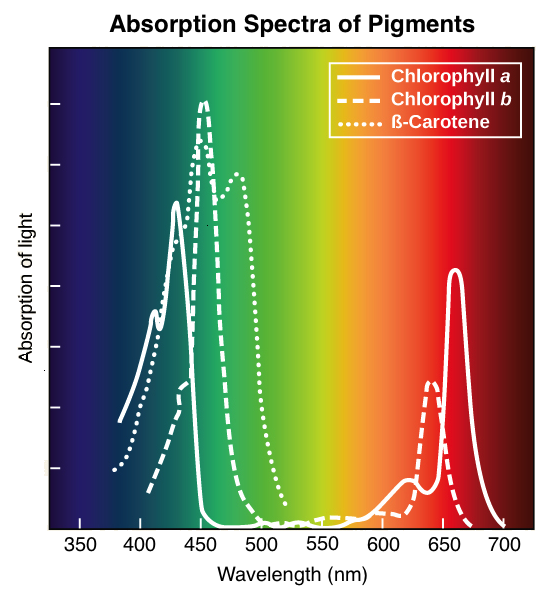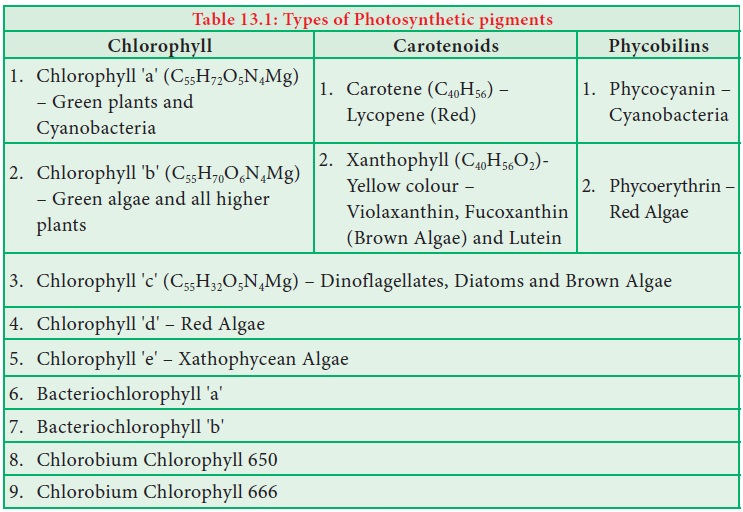Describe Different Types of Photosynthetic Pigments and Explain Their Role
Different accessory pigments absorb different wavelengths of light. Among them chlorophyll a is the chief pigment associated with photosynthesis and others are known as accessory pigments.

Biology Notes For A Level 101 Photosynthetic Pigments
Five types of chlorophylls occur in plants other than bacteria a b c d and e.

. The rate of photosynthesis is the least with green-yellow light 525 nm-625 nm. In the diagram below you can see the absorption spectra of three key pigments in photosynthesis. Chlorophyll a is the primary light-absorbing pigment in plant leaves.
Chlorophyll a found in algae cyanobacteria and in all higher plants. The photosynthetic plants have. The set of wavelengths that a pigment doesnt absorb are reflected and the reflected light is what we see as color.
Geronoplasts refer to the chloroplasts of the leaves that help to convert into different other organelles when the leaf is no longer using photosynthesis usually in an autumn month. What is photophos phorylation. Chlorophyll b found only in green algae and in higher plants.
It absorbs light wavelengths in the red and blue range and reflects back green waves which gives most leaves their distinctive green color. -Describe the role of porphyrin rings in the evolution of-photosynthetic pigments bacteriochlorophyll and chlorophyll a and anoxygenicoxygenic photosynthesis. Impacts on Earths atmosphere.
View Text Solution 3. Carotenoids cannot transfer sunlight energy directly to the photosynthetic pathway but must pass their absorbed energy to chlorophyll. Photosynthetic pigment - Carotenoids Carotenoid is the organic pigment produced by the plants algae even some bacteria and fungi.
Relate the redox reactions of an electron transport chain to the active. The three main types of photosynthesis are C 3 C 4 and CAM crassulacean acid metabolism. Chlorophyll Is the main pigment contained in chloroplasts.
Heterotrophs- are consumers that get energy by feeding on autotrophs. In college I had to memorize some of their pathways and mechanisms but I will highlight what gives one an advantage over another and what types of crops forages and weeds have specialized C 3 and C 4 photosynthesis. There are three types of pigments present in the leaves of plants and their retention or production determines the colors of leaves before they fall from molecules beyond the simple chemical formulas that describe the numbers of atoms of different elements making up the molecule.
Explain why chlorophyll a is considered the main photosynthetic pigment in plants and chlorophyll b and other pigments are considered accessory. To understand their function it is necessary to know the chloroplast structure and function that plays an important role in the process of photosynthesis. What is the Function of Accessory Pigments.
This is why plants appear green to us. The four types of phycobilins are phycoerythrobilin phycourobilin phycoviolobilin and phycocyanobilin. White pigments reflect most of the wavelengths striking them.
Describe noncyclic photophosphorylation with schematic representation. Algae also contain other photosynthetic pigments such as carotenoids and phycobilins. For this reason they are called accessory pigments.
Red-orange light 625nm-700nm shows a good rate of photosynthesis. Chlorophyll is the primary pigment that. 1 Chloroplasts- are the green plastids which contain chlorophyll pigments for photosynthesis.
However none of these should be considered a photosynthetic pigment. The best rate of photosynthesis is seen with violet-blue light 400nm-525nm. Describe the different types of photosynthetic pigments and explain their role.
Chlorophyll a chlorophyll b and β-carotene. These are the non-pigmented organelles which are colourless. Carotenoids the most common accessory pigments absorb extra blue wavelengths.
Xanthophyll is an oxygen derivative. 1 bacteriochlorophyll carry out anoxygenic photosynthesis. The different types of chlorophyll pigments are.
This will tell us why they can do well in certain. Chlorophyll the green pigment common to all photosynthetic cells absorbs all wavelengths of visible light except green which it reflects. There are two groups of carotenoid carotene and xanthophyll.
There are major 3 types of photosynthetic pigments namely. Such pigment molecules include anthocyanins flavanoids flavines quinones and cytochromes just to name a few. Chlorophyll a b c.
Also Phycobilins are mostly found in cyanobacteria and red algae while as. Like plants algae contain photosynthetic organelles called chloroplasts. Carotene is the polyene hydrocarbon.
Suggest the type o f photophosphory lation during which oxygen is evolved. The pigment present in them is carotene which gives. Leucoplasts are usually found in most of the non-photosynthetic parts of the plant like roots.
2 Chromoplasts- are the coloured plastids for pigment synthesis and storage. One very visible accessory pigment is fucoxanthin the brown pigment which colors kelps and other brown algae as well as the diatoms. The set of wavelengths absorbed by a pigment is its absorption spectrum.
Describe where the electron given off by photosystem I goes and where the electron given off by photosystem II goes. They are the green photosynthetic pigments. Different photosynthetic organisms have a variety of different pigments so they can absorb energy from a wide range of wavelengths.
Black pigments absorb all wavelengths of visible light that strike them. Chlorophyll c found in certain photosynthetic Chromista and in some. The wavelengths that is does not absorb are reflected from it.
Autotrophs- include plants algae and cyanobacteria and are photosynthetic organisms. Chloroplasts contain chlorophyll a green pigment which absorbs light energy for photosynthesis. It plays an important role in plant health.
View Text Solution 4. There are many different types of non-chlorophyll accessory pigments but some of the most common are carotenoids phycocyanins and phycoerythrins. The major photosynthetic pigments are.
Chlorophyll Carotenoids and Phycobilins. Photosynthetic pigments are the only pigments that have the ability to absorb energy from sunlight and make it available to the photosynthetic apparatus. Algae can be unicellular or can exist as large multicellular species.
The types of plastids are-. The following points highlight the two main types of photosynthetic pigments. Types of Accessory Pigments.
Both use organic molecules produced by photosynthesis as a source of building blocks for growth and repair and as a source of chemical energy for cellular work.

What Is The Function Of The Photosynthetic Pigments In Photosynthesis Lisbdnet Com

Photosynthetic Pigments Chlorophyll Carotenoids Phycobilins

Wavelengths Of Light And Photosynthetic Pigments Article Khan Academy
Comments
Post a Comment